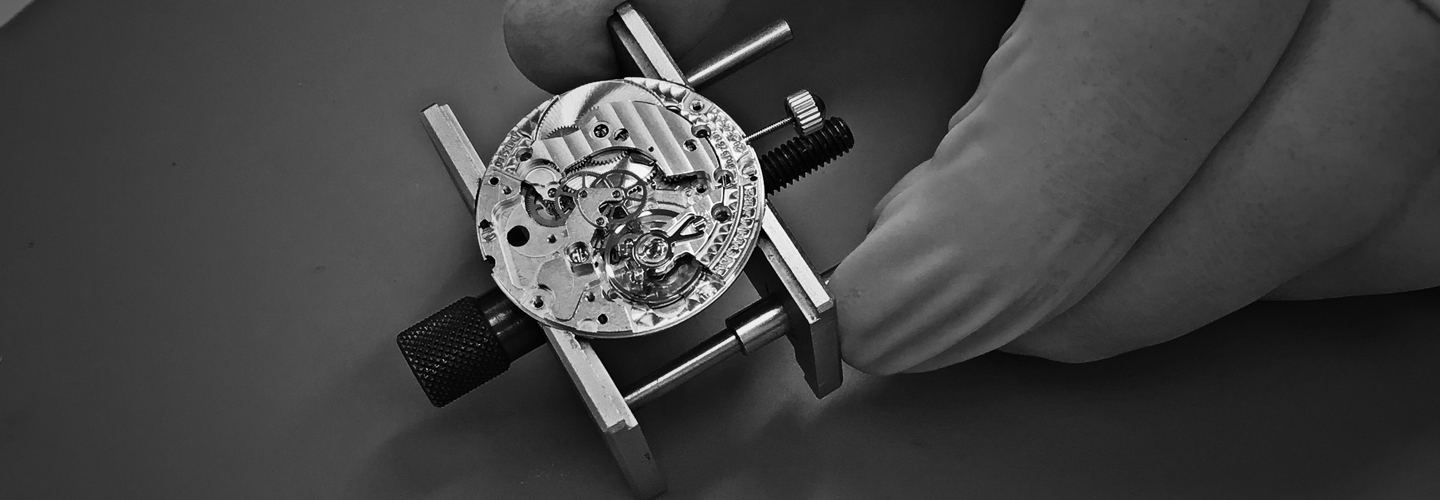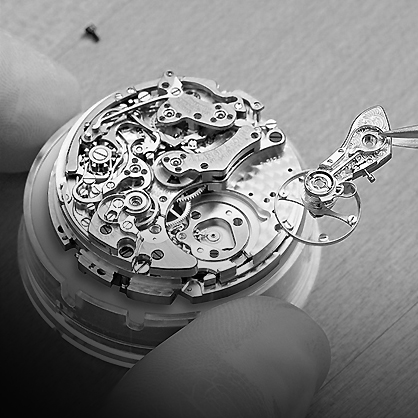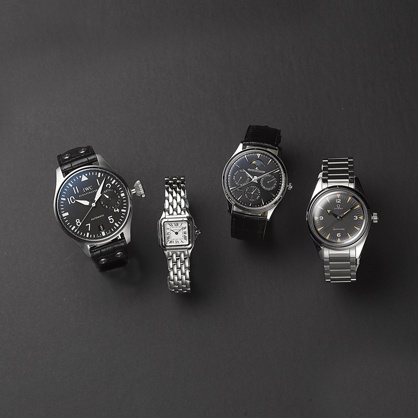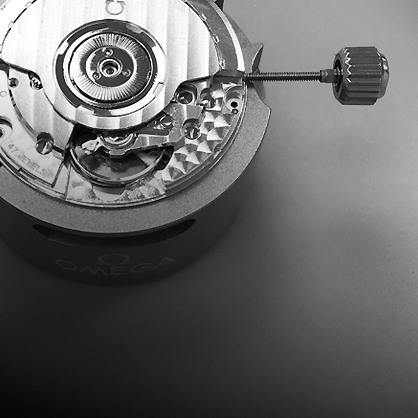Watch Glossary
Learn about the different parts of a watch, from the intricate mechanisms and types of materials used, to the various complications and more.
A
Annual Calendar
A calendar function that automatically adjusts between 30 and 31 day months. Simply put, it only needs manual adjustment on the 1st March each year to account for the 28th or 29th February
Anti-Magnetic
Depending on its strength magnetism can have a negative effect on the timekeeping of mechanical watches. Antimagnetic watches have protection against magnetic fields.
Analogue
A watch where the time is indicated by hands moving around the dial.
Aperture
A small opening on a dial through which information such as the date, day of the week or year can be seen.
A type of watch where the mainspring is wound by the movement of the wearers arm. Automatic watches are sometimes called “self-winding”.
B
Balance
Comprising of a wheel and spiral-shaped spring that’s considered to be the heart of a watch. The balance wheel performs a similar function to a pendulum in a clock, rotating back and forth driven by the impulse of the balance spring. Each swing of the wheel ultimately allows the gear train to move forward, advancing the hands.
Barrel
Appears as a round box with teeth around the outside in a mechanical watch movement. Within the box is the mainspring where the energy from winding is stored. The teeth connect to the gear train and slowly release their energy to the movement.
Bezel
A ring that surrounds the dial of a watch. It serves two purposes. Either decoratively or functional. An example of a decorative bezel is one that is set with diamonds or other precious stones. A functional bezel would be inscribed with a scale, such a Tachymeter or hours for a multiple time zone watch.
Baton
An index or stick-like maker on the dial to indicate the hours.
Bridge
A part of the movement that’s attached to the base plate and supports a mobile part of the movement, such as the barrel bridge.
C
Cabochon
A dome shaped precious or semi-precious gemstone placed in the crown or lugs on a watch.
Case
The main part of a watch and in which the movement sits. The case performs a dual purpose: firstly, to protect the movement from shocks, dust and water and secondly to provide an aesthetically pleasing look to the watch.
A chronograph watch is a watch with a stopwatch function that allows the user to time races or any other event.
Chronometer
A certificate awarded to watches that meeting the time keeping standards set by COSC.
COSC Certified
Controle Officiel Suisse des Chronometres is the authority based in Switzerland that test watches under a variety of temperatures and positions to assess their accuracy. To achieve COSC certification the watch must perform to a maximum variance of minus 4 to plus 6 seconds per day.
An additional function beyond simply telling the time. Examples would be such items as chronograph, moonphase and power reserve functions.
Crown
A button, usually fluted or knurled on the side of the case to enable the winding of the movement or resetting the time or date.
D
Dial
The “face” of the watch that usually includes the markers for hours and minutes and can be decorated with diamonds, engraved with patterns or simply coloured.
DLC
Stands for Diamond Like Carbon, a surface treatment made up of very thin but hard layers of amorphous carbon.
Digital
The time display on a watch indicated by digits as opposed to analogue, where hands point to numbers on the dial.
Diver’s Watch
Dive watches should comply with ISO6425 that determines a minimum water resistance of 100M, a screw down crown, visibility at 25cm in total darkness and some way to time a dive, usually via a bezel.
Dual Time
E
Enamel
A clear substance then when heated acquires a glass-like consistency. Colour is most often added to create vibrant effects on the dial.
Escapement
The part of a watch movement that maintains the distribution of energy to the balance wheel and balance spring.
F
Flyback
Found on chronographs and is a function that instantly stops, resets and restarts the stopwatch. It’s sometimes written in French as “Retour en vol”, or “return in flight”.
Flying Tourbillon
Unlike a regular tourbillon a flying one is fixed at one point giving an unobscured view of the tourbillon mechanism to give the impression of floating or flying.
Frequency
This is the number of oscillations per second and is measured in Hertz. It relates to the oscillations or vibrations of the balance and the higher the number the more accurate the timekeeping. Typically, a 4 Hertz movement produces 28,800 vibrations per hour.
Folding Buckle
Also known as a deployant buckle, is found on strap watches and is an articulated clasp differing from a regular pin buckle.
G
Geneva Seal
Also known as the “Poincion de Geneve” and is awarded to watch movements of the highest standards of quality and finishing produced within the Canton of Geneva. The twelve criteria must be met before the Genevan coat of arms can be engraved on the movement.
Greenwich Mean Time was the standard adopted in 1884 that divided the world into 24 time zones based on Greenwich in London being the reference point. Watches, with a second time zone came to be known as GMT watches.
Grande Complication
A term applied to a watch with at least three complications such as a perpetual calendar, split seconds chronograph or minute repeater.
Grande Sonnerie
Strikes the hours and quarters automatically and the hours, quarters and minutes when activated by a slider or push piece on the watch.
Guilloché
An intricate, repeated pattern creating a decorative effect on a dial or movement part produced either by hand or machine.
H
Hacking Seconds
Enables a mechanical watch to be accurately set as the seconds hand stops when the crown is pulled out.
Helium Escape Valve
Exclusively on some diving watches and allows the escape of helium from the movement that can build up in saturation diving. The gas is expelled either automatically or by unscrewing a value on the side of the case.
Hunter Case
J
Jewels
Within movement synthetic rubies are used to reduce friction between moving parts.
Jumping Hour
The hour numeral that appears in an aperture on the dial of a watch and jumps to the next number after 60 minutes have passed.
L
Luminescence
The hands and numerals on a dial are often coated in a luminescent substance so that they glow in low light or darkness. Many brands use Super-LumiNova, a non-toxic, non-radioactive substance that glows for up to fifteen hours in darkness.
M
Mainspring
Located in the Barrel this is a coiled spring made from a steel alloy that’s highly elastic. When wound up it provides the power in a mechanical watch.
Manufacture
Describes a Swiss watch factory that manufactures the majority of the parts that it uses to produce its watches, as opposed to simply buying in parts from a third party and assembling them.
A mechanical movement that requires the mainspring to be wound up via the crown to power the watch.
METAS
A Swiss authority whose expertise is in the field of measurement, calibration and testing. Watches that are METAS certified undergo eight tests including performance under magnetic conditions, water resistance and accuracy with low power reserve.
Minute Repeater
A complication that upon activation sounds the time via a series of chimes. Minute Repeaters sound the hour, quarter and minutes.
Moon Phase
A display on a dial that shows the four main phases of the moon as it revolves around the earth. New, First Quarter, Full Moon and Last Quarter.
Movement
Like the engine in a car, the Movement describes the combination of components that make the watch function.
Learn more about the different types of movements on our Watch Movements page.
P
Perpetual Calendar
A mechanical watch whose calendar automatically adjusts for 30 and 31 day months (like the Annual Calendar) but also automatically adjusts for Leap Years.
Perlage
A decorative finish applied to parts of a mechanical watch movement and consists of small overlapping circles.
Petite Sonnerie
Unlike a Grande Sonnerie, the Petite chimes the hour at the top of each hour and only the quarters at each quarter without repeating the hour.
Power Reserve
In a mechanical watch its the length of time it will run for when fully wound. The minimum is usually 36 hours, but many watches are now at 70 hours and some are even 7 days. Sometimes the Power Reserve is indicated on the dial via a small gauge, rather like a petrol gauge on a car.
PVD
Physical Vapour Deposition is the application of thin layers of material to a watch case for decorative purposes.
Q
A quartz watch is an electronic watch, powered by a battery and including a quartz crystal that oscillates at a very high frequency (32,768 Hertz) and regulates the timekeeping.
R
Rattrapante
A French word that roughly translates to “catch up” in English and describes a highly complicated Chronograph that features two seconds hands, one placed above the other and enables the timing of a one-two finish in a race. The Rattrapante function is usually activated by a third Chronograph button placed on the left-hand side of the watch. It’s also known as a Split Seconds Chronograph.
Regulator
This type of watch does not present the time in the conventional manner with the hour, minute and seconds hands all centrally placed on the dial on a common axis. Rather, the three hands are separately placed with idea that the legibility of each is improved. Originally Regulator clocks were placed in workshops to enable watchmakers to easily reference the time when adjusting (or regulating) the watch they were working on.
Retrograde
Meaning to move backwards and describes a hand on a watch that travels the length of its scale and then moves back to the start. For example, an hour hand that moves from 1 to 12 and returns back to 1 to start all over again after 12 hours.
S
Sapphire Crystal
A synthetic crystal used above the dial on a watch. It’s highly scratch resistant and hard making it ideal for watch glasses.
Screw-Down Crown
Most often found on diving watches and allows the crown to be screwed into the case to better prevent water from entering.
Skeleton
Also, known as “Squelette” in French and describes a type of mechanical watch with no dial, exposing the beauty of the movement to the naked eye.
Split-Second Chronograph
See Rattrapante.
Subdial
A small dial located within the main dial that displays additional functions, such as the moon phase or the minute or seconds register of a chronograph.
T
Tachymeter
A numerical scale usually found on the bezel of a chronograph and is used to compute speed or distance when the chronograph is running.
Tourbillon
French for “Whirlwind” and describes a cage which houses the escapement and balance in a mechanical movement. Usually, the mechanism rotates once every 60 seconds and is designed to eliminate errors caused by the effects of gravity on the movement, leading to greater timekeeping accuracy.
Tonneau
U
Unidirectional Rotating Bezel
A bezel that only rotates one way and is commonly used on Diver’s watches. Designed as a timing safety feature because if the bezel moves it only shortens the dive time so the diver will not run out of air.
V
Vibration
See Frequency. Usually refers to Vibrations Per Hour, which is the number of beats the balance performs in one hour.
W
Water Resistant
A watch’s water resistance rating indicates how waterproof a watch is before water gets in. Typically, the resistance is measured in metres or by pressure denoted by either ATM (Atmospheres) or Bar. ATM refers to air pressure with 1 ATM being the equivalent pressure at sea level. 1 ATM is equivalent to 1 Bar. 10 ATM gives a water resistance to 100 metres.
Learn more about winding and setting your watch on our Watch Maintenance page.
Watch Guides
Find out more about watches.
Watch CLP Page
Contact us


